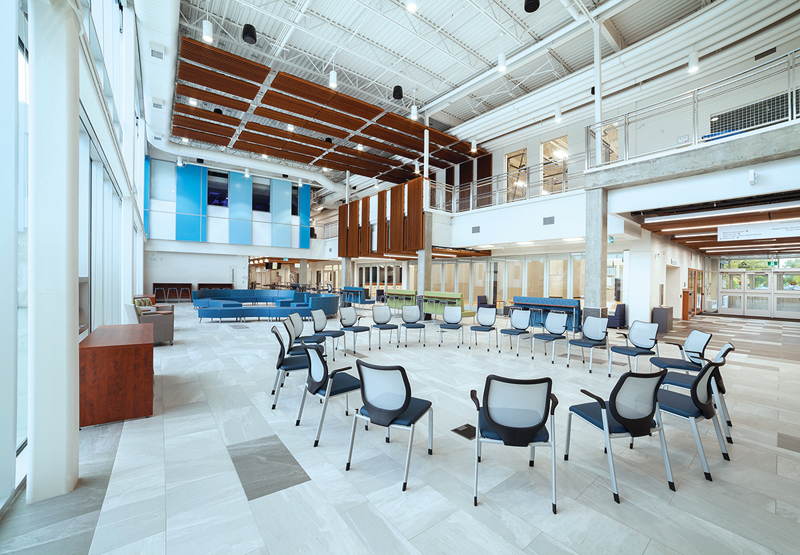State of the Nation: Saskatchewan
Ten years ago, the thriving market in oil, gas and potash led to a “Saskaboom,” which brought along plenty of work for architects. The economy has declined significantly since then. But with relatively few architects in the province—about 110 in all—there is still enough work to go around. “Firms seem to be adapting to the new normal, where the work is slow but steady,” says James Youck of Regina-based P3Architecture Partnership (P3A).
For a small community of practice, Saskatchewan architects are behind some impressively progressive ideas. Indigeneity has been a topic of conversation in the provincial association’s last three annual conferences. It’s a pressing matter in a province where sixteen percent of the population identifies as Aboriginal. The Gordon Oakes Red Bear Student Centre at the University of Saskatchewan in Saskatoon, designed by Douglas Cardinal to provide resources to Indigenous students and opened in 2016, occupies a prime spot on the main academic quadrangle. Moreover, “firms are looking at how truth and reconciliation can affect not just aesthetics, but the process by which projects are delivered,” says Youck.
“How do you work in that space of reconciliation, without being yourself Indigenous?” asks Jim Siemens of Oxbow Architecture, who is also the current SAA president. The answer: very carefully. “There are many practitioners here carrying on and striving to do just that,” he says.
One manifestation of this approach might be seen at the mâmawêyatitân centre in Regina, by P3A. Indigenous community members were engaged as part of an in-depth local consultation process. Named with a Cree word meaning “let’s all be together,” the building is a shared use facility, jointly funded by the city, the library, and the local school board. It includes a high school, daycare, community policing centre, and recreational complex, among other functions. But instead of each group having its own entrance and perhaps sharing hallways, the centre is more deeply integrated—at the programming level as well as from a service and delivery perspective. “70 percent of the Centre’s spaces are shared between groups, while only 30 percent of the space is dedicated to a single group,” says James Youck.

There has also been an ongoing discussion with the University of Saskatchewan about starting a school of architecture; Indigenous placemaking could well be one focus of such an institution. But the process has stalled out, and a timeline for reviving it isn’t clear. Still, local architects feel that having an architecture school would give a significant boost to the design culture of the province. A can-do attitude, grounded in the region’s pioneer history, can sometimes result in a good-enough mentality among clients, says Youck. “If all you need is a roof over your head, you may feel a pre-engineered building is enough—why would you look to push a design further?” Adds Derek Kindrachuk, of Saskatoon’s Kindrachuk Agrey Architecture, “A school of architecture would be huge for our city and province—it would go a long ways in fostering appreciation for what architecture can be.”
In the meanwhile, local firms are working in increments to demonstrate architecture’s potential for creating transformative private and public places. The residential component of Oxbow’s practice, for instance, stemmed in part from a commission for a Kinsmen lottery house, to be raffled off for the charity. “People in Saskatoon love touring lottery homes,” says Jim Siemens, describing how as a Friday night excursion, a couple might opt to visit an open house at a lottery home, rather than going to the movies. In contrast to the typical suburban houses offered as prizes by the charity, Oxbow worked on an urban infill site to create a modern house that respected traditional massing and alignments.
The result has garnered many positive reactions. “People innately understand architecture,” says Siemens, “In some way, things like lottery houses give them access to that.”

Regional building typologies are also at the heart of a project by Kindrachuk Agrey which is bound to have instant, intuitive appeal. They’re designing an aging-in-place wellness community modelled on the De Hogeweyk dementia care village in the Netherlands. The forward-thinking environment located in the Village at Crossmount will support residents in a safe, non-institutional environment that includes outdoor plazas and a grocery store, library, restaurant, theatre and other amenities, including a daycare supporting intergenerational care. Residents will have private bedrooms in small-scale group homes, with like-minded peers. “There will be all the things you need to carry on with regular daily activities, supported by caregivers,” says Derek Kindrachuk. “There’s nothing like this around in North America.”
The Dutch complex on which De Hogeweyk at Crossmount is based opened in 2009 and has seen residents with advanced dementia who are more active and at ease than at typical nursing homes. The founders of De Hogeweyk have endorsed the Saskatchewan project and are supporting its development team.

At a larger scale, the recently opened Remai Modern gallery, designed by KPMB Architects, provides an important civic space for Saskatoon. There is discussion over new central libraries in Regina and Saskatoon. A convention centre and downtown arena may also be in the works for Saskatoon, when funding becomes available.
Perhaps the most frequented public space in the province is a building that’s not architecturally distinguished: the new stadium in Regina. The immensely popular Roughriders are known for their loud, proud and loyal fan base. Siemens wonders if it might be possible to cultivate a similar sentiment for the province’s arts and architecture. “If we were that proud of our symphony, our gallery, imagine the increased impact that the arts and design could have in our community.”
This article is part of our State of the Nation series covering Canadian architecture region by region.
